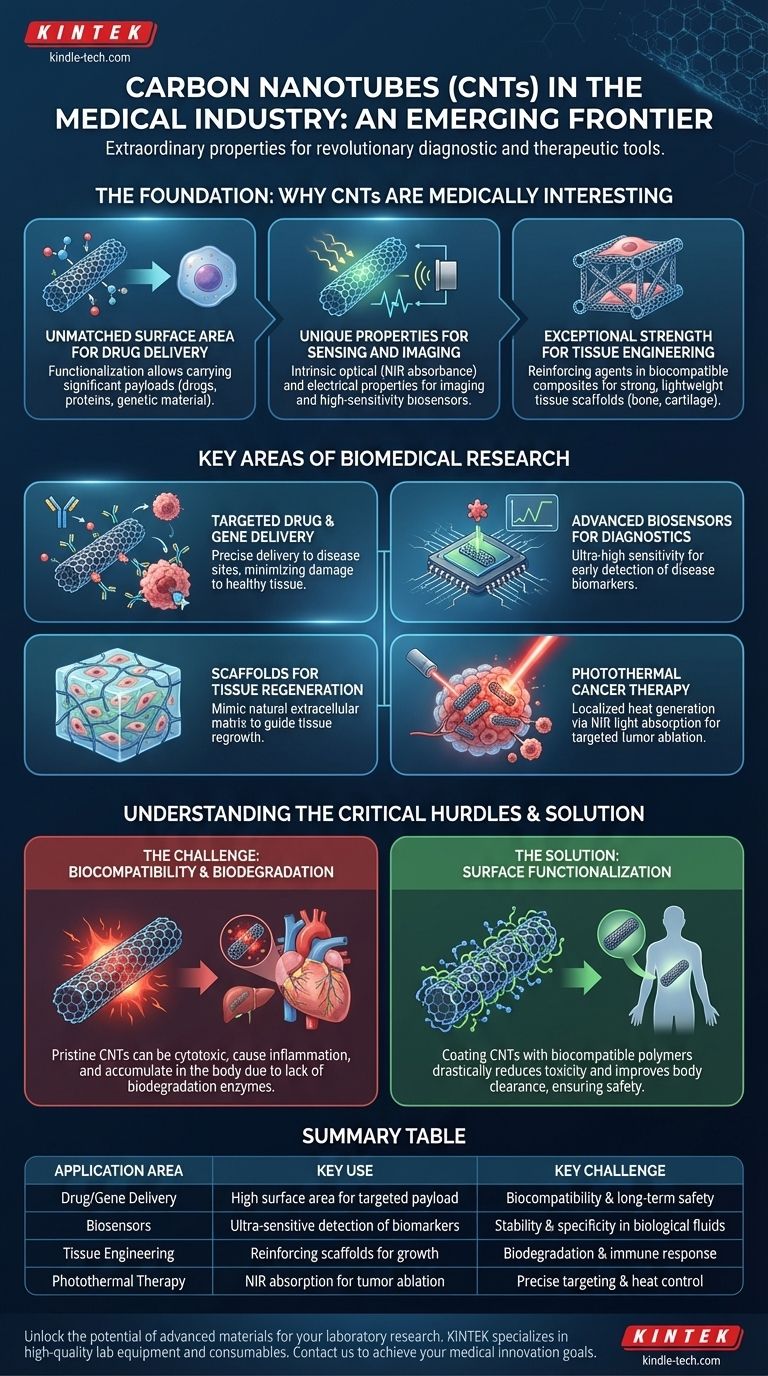While current commercial applications of carbon nanotubes (CNTs) focus heavily on industrial sectors, their extraordinary properties have made them a cornerstone of cutting-edge biomedical research. The provided references highlight their established use in batteries, electronics, and composites, but the medical industry represents an emerging frontier. Researchers are actively exploring how the unique nanoscale characteristics of CNTs can be leveraged to create revolutionary diagnostic and therapeutic tools.
The central challenge and opportunity with carbon nanotubes in medicine is a duality: their unparalleled physical and chemical properties offer immense potential for drug delivery and biosensing, but this potential can only be unlocked by overcoming significant hurdles related to biocompatibility and long-term safety.

The Foundation: Why CNTs Are Medically Interesting
Before exploring specific applications, it is essential to understand why these structures are so compelling for biomedical engineering. Their value originates from a unique combination of properties not typically found together in a single material.
Unmatched Surface Area for Drug Delivery
Carbon nanotubes possess an exceptionally high surface-area-to-volume ratio. This vast surface can be "functionalized"—a process of attaching other molecules—to carry significant payloads of drugs, proteins, or genetic material.
Unique Properties for Sensing and Imaging
CNTs have intrinsic optical and electrical properties, such as strong absorbance in the near-infrared (NIR) spectrum. This allows them to be used both for imaging purposes and as highly sensitive components in biosensors designed to detect specific biomarkers.
Exceptional Strength for Tissue Engineering
With a tensile strength far exceeding that of steel, CNTs can serve as reinforcing agents in biocompatible polymer composites. These composites can be used to create strong, lightweight scaffolds that support and guide the regrowth of tissue, such as bone or cartilage.
Key Areas of Biomedical Research
This combination of properties has fueled intense research across several key medical domains. While most applications are not yet in routine clinical use, they demonstrate the transformative potential of the technology.
Targeted Drug and Gene Delivery
By attaching targeting molecules (like antibodies) to their surface, CNTs can be engineered to seek out and bind to specific cells, such as cancer cells. This allows for the precise delivery of potent drugs directly to the disease site, minimizing damage to healthy surrounding tissue.
Advanced Biosensors for Diagnostics
CNT-based transistors can detect the presence of a single target molecule. This ultra-high sensitivity makes them ideal for next-generation diagnostic tools capable of identifying disease markers in blood or saliva at the earliest possible stages.
Scaffolds for Tissue Regeneration
When integrated into hydrogels or other biomaterials, CNTs create mechanically robust structures that mimic the natural extracellular matrix. These scaffolds provide the physical support and electrical cues that cells need to organize and regenerate damaged tissues.
Photothermal Cancer Therapy
Because CNTs absorb NIR light, they can be used for targeted thermal ablation. After accumulating in a tumor, they can be heated by an external laser that passes harmlessly through healthy tissue. The localized heat generated by the CNTs then destroys the cancer cells.
Understanding the Critical Hurdles
Despite the enormous potential, significant challenges must be addressed before CNTs can be widely adopted in clinical practice. Objectivity requires acknowledging these risks, which are the primary focus of ongoing safety research.
The Question of Biocompatibility
In their pristine, unmodified state, carbon nanotubes can provoke an inflammatory response from the immune system and may exhibit cytotoxic effects. Their needle-like shape can cause physical damage to cell membranes if not properly processed.
The Challenge of Biodegradation
The human body lacks the natural enzymes to effectively break down and clear carbon structures. This raises concerns about the potential for long-term accumulation in organs like the liver and spleen, and the unknown consequences of this bio-persistence.
The Solution: Surface Functionalization
The key to overcoming these safety concerns lies in surface functionalization. By coating CNTs with biocompatible polymers (like PEG), their toxicity is drastically reduced, and their ability to be cleared from the body is improved, making them far safer for medical use.
The Path from Lab to Clinic
Navigating the transition from promising research to approved medical application requires a clear understanding of the technology's maturity and its associated challenges.
- If your primary focus is near-term application: Recognize that CNTs are still largely in the research and development phase for medical use, with advanced biosensors being one of the more mature areas.
- If your primary focus is long-term therapeutic potential: Focus on the research around functionalized CNTs for targeted drug delivery and tissue engineering, where the most transformative clinical impact may lie.
- If your primary focus is on investment or commercialization: Prioritize understanding the complex regulatory landscape and the ongoing toxicology studies, as these will be the most significant barriers to market entry.
Ultimately, harnessing the medical potential of carbon nanotubes depends entirely on mastering their safe and predictable interaction with biological systems.
Summary Table:
| Application Area | Key Use of CNTs | Key Challenge |
|---|---|---|
| Drug/Gene Delivery | High surface area for targeted payload delivery | Biocompatibility and long-term safety |
| Biosensors | Ultra-sensitive detection of biomarkers | Ensuring stability and specificity in biological fluids |
| Tissue Engineering | Reinforcing scaffolds for bone/cartilage growth | Biodegradation and immune response |
| Photothermal Therapy | Near-infrared absorption for tumor ablation | Precise targeting and heat control |
Unlock the potential of advanced materials for your laboratory research. KINTEK specializes in providing high-quality lab equipment and consumables to support cutting-edge biomedical applications, including nanotechnology and material science. Whether you are developing next-generation drug delivery systems or sensitive diagnostic tools, our products are designed to meet the rigorous demands of your research. Contact us today to learn how we can help you achieve your medical innovation goals.
Visual Guide

Related Products
- Boron Nitride (BN) Ceramic Tube
- Custom PTFE Teflon Parts Manufacturer for Centrifuge Tubes
- Multi Zone Laboratory Quartz Tube Furnace Tubular Furnace
- High-Purity Titanium Foil and Sheet for Industrial Applications
- Silicon Carbide SiC Thermal Heating Elements for Electric Furnace
People Also Ask
- What are 4 applications of carbon nanotubes? Enhancing Batteries, Composites, Electronics & Sensors
- What are the disadvantages of brazing? Understanding the key limitations and trade-offs.
- What are the strengths of brazing? Achieve Strong, Clean, and Precise Metal Joining
- What are 4 disadvantages of brazing? Understanding the Critical Limitations of This Joining Method
- What are the disadvantages of brazing? Key Challenges in Material Joining



















